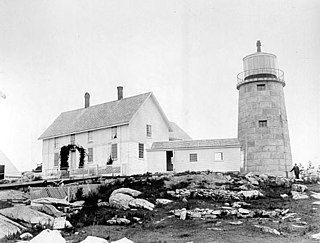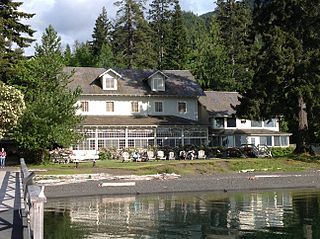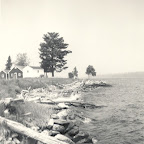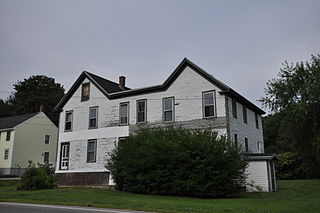
Eagle Island is an island in Maine's Casco Bay and the site of the summer home of the polar explorer Admiral Robert Peary (1856-1920). The island and home are preserved as the Eagle Island State Historic Site

National Park Service rustic – sometimes colloquially called Parkitecture – is a style of architecture that developed in the early and middle 20th century in the United States National Park Service (NPS) through its efforts to create buildings that harmonized with the natural environment. Since its founding in 1916, the NPS sought to design and build visitor facilities without visually interrupting the natural or historic surroundings. The early results were characterized by intensive use of hand labor and a rejection of the regularity and symmetry of the industrial world, reflecting connections with the Arts and Crafts movement and American Picturesque architecture.

The Santanoni Preserve was once a private estate of approximately 13,000 acres (53 km²) in the Adirondack Mountains, and now is the property of the State of New York, at Newcomb, New York.

Montgomery Place, now Bard College: The Montgomery Place Campus, near Barrytown, New York, United States, is an early 19th-century estate that has been designated a National Historic Landmark. It is also a contributing property to the Hudson River Historic District, itself a National Historic Landmark. It is a Federal-style house, with expansion designed by architect Alexander Jackson Davis. It reflects the tastes of a younger, post-Revolutionary generation of wealthy landowners in the Livingston family who were beginning to be influenced by French trends in home design, moving beyond the strictly English models exemplified by Clermont Manor a short distance up the Hudson River. It is the only Hudson Valley estate house from this era that survives intact, and Davis's only surviving neoclassical country house.

The Murie Ranch Historic District, also known as the STS Dude Ranch and Stella Woodbury Summer Home is an inholding in Grand Teton National Park near Moose, Wyoming. The district is chiefly significant for its association with the conservationists Olaus Murie, his wife Margaret (Mardy) Murie and scientist Adolph Murie and his wife Louise. Olaus and Adolph Murie were influential in the establishment of an ecological approach to wildlife management, while Mardy Murie was influential because of her huge conservation victories such as passing the Alaska National Interest Lands Conservation Act of 1980 and being awarded with the highest civilian honor, the Presidential Medal of Freedom, for her lifetime works in conservation. Olaus Murie was a prominent early field biologist in the U.S. Biological Survey and subsequent U.S. Fish and Wildlife Service before retiring and becoming the president of the Wilderness Society, He was a prominent advocate for the preservation of wild lands in America.
The Redick Lodge, also known as the Chambers Lodge, is a private seasonal retreat on Upper Fremont Lake near Pinedale, Wyoming in the Wind River Range at an elevation of 7,500 feet (2,300 m). The lodge was designed by architect Otis Miller of Miles City, Montana as a log cabin on a stone foundation for George M. Redick, a Nebraskan who had worked with the Union Pacific Railroad on potential locations for company hotels. The Redick family spent summers at the lodge from 1918 through 1931, when family fortunes declined. The property was purchased by Dr. Oliver Chambers of Rock Springs, Wyoming in 1938 and has remained in the Chambers family.
Roaring River State Park is a public recreation area covering of 4,294 acres (1,738 ha) eight miles (13 km) south of Cassville in Barry County, Missouri. The state park offers trout fishing on the Roaring River, hiking on seven different trails, and the seasonally open Ozark Chinquapin Nature Center.

Whitehead Light is a lighthouse on Whitehead Island, on Muscle Ridge Channel, in the southwestern entrance to Penobscot Bay, Maine. It is in the town of St.George. Established in 1804, it is one of Maine's oldest light stations, with its present tower built in 1852 to a design attributed to Alexander Parris. It was listed on the National Register of Historic Places as Whitehead Light Station on March 14, 1988. The property is now owned by not for profit Pine Island Camp. Whitehead light station offers to the public various stays at the light station from getaway weekends to learning retreats and renting the station as a vacation home. The light itself remains an active aid to navigation, maintained by the United States Coast Guard.
Louise Dickinson Rich was a writer known for fiction and non-fiction works about the New England region of the United States, particularly Massachusetts and Maine. Her best-known work was her first book, the autobiographical We Took to the Woods, (1942) set in the 1930s when she and husband Ralph, and her friend and hired help Gerrish, lived in a remote cabin near Umbagog Lake. It was described as "a witty account of a Thoreau-like existence in a wilderness home."

The James Cant Ranch is a pioneer ranch complex in Grant County in eastern Oregon, United States. The ranch is located on both sides of the John Day River in the John Day Fossil Beds National Monument. The ranch was originally homesteaded by Floyd Officer in 1890. Officer sold the property to James Cant in 1910. Cant increased the size of the property and built a modern ranch complex on the west bank of the river. The National Park Service bought the ranch from the Cant family in 1975, and incorporated the property into the John Day Fossil Beds National Monument. The National Park Service used the main house as a visitor center until 2003. Today, the Cant Ranch complex is preserved as an interpretive site showing visitors an early 20th-century livestock ranch. The James Cant Ranch is listed on the National Register of Historic Places.

Lake Crescent Lodge, originally called Singer's Lake Crescent Tavern, is a historic resort situated on the shores of Lake Crescent west of Port Angeles, Washington. Located on the Olympic Peninsula within Olympic National Park, the Lodge is owned by the National Park Service and operated by Aramark. The Lodge resort is open seasonally from early May until the end of January with select cabins available during the winter months. Hiking and boating are popular activities for guests, and several peaks, including Mount Storm King and Pyramid Mountain, are easily accessible from the resort. Other hiking opportunities include Marymere Falls, Spruce Railroad, and Barnes Creek Trails.

The Redden Forest Complex is located in Redden State Forest, Sussex County, Delaware. Now known as the Redden Forest Education Center, the complex includes three Shingle style buildings built in 1900-1902 as a hunting retreat for Pennsylvania Railroad heir Frank Graham Thompson. The complex was served by a specially built railroad siding in Redden Crossroads. The camp fell into disuse during the Great Depression and was acquired by the state of Delaware in the 1930s. It saw use by the Civilian Conservation Corps, then the complex and the surrounding property were designated Redden State Forest in 1937.

Taylor Memorial Chapel at La Foret Conference and Retreat Center is a historic chapel in Black Forest, Colorado. It is a National Register of Historic Places listing.

The Brickett Place is a historic farmstead in rural Oxford County, Maine, United States. It is located in the White Mountain National Forest on Maine State Route 113, in the small town of Stow. Built from 1812 to 1816 by John Brickett out of handmade bricks, it is an idiosyncratic expression of Federal architecture in an unusually remote setting, and is the oldest building in the United States Forest Service's Eastern Region. It was listed on the National Register of Historic Places in 1982. It is currently used by the United States Forest Service as a seasonal visitors center, with interpretive displays about the area's history.

Chesuncook is a small unincorporated settlement on the northwestern shore of Chesuncook Lake in rural central Piscataquis County, Maine. A small village, originally supporting logging operations in the area, has existed here since at least the time of Henry David Thoreau, who wrote about it in The Maine Woods. The village is now a primarily seasonal settlement that caters principally to outdoors enthusiasts. Seven historic properties on or near the "Main Street" fronting the lake were listed on the National Register of Historic Places in 1973.

The Perkins Homestead, also known as the Brick House, is a historic homestead at 478 River Road in Newcastle, Maine. The 57-acre (23 ha) property, including its 1837 brick farmhouse, was designated a National Historic Landmark for its association with the life of Frances Perkins (1880–1965), the first woman to hold a position in the United States Cabinet. Perkins spent many years, both as a child and later as an adult, at this property, which she considered to be her true home. The property was first listed on the National Register of Historic Places in 2009 as the Brick House Historic District in part for its archaeological significance.
Shore Acres is a historic former summer hotel at 791 Lamoine Beach Road in Lamoine, Maine. With a possible construction history dating to about 1800, it is one of the coastal community's oldest buildings, and is the only surviving 19th-century hostelry in the town. Extensively altered in 1887 and operated as an inn between 1887 and 1942 as the Des Isles Inn, it is now a summer rental property, located within walking distance of Lamoine Beach State Park. The property was listed on the National Register of Historic Places in 2000.

Pittston Farm is a historic farm and community complex in a remote part of northern Somerset County, Maine. Located down logging roads about 20 miles (32 km) north of the village of Rockwood, the farm was developed c. 1910 by the Great Northern Paper Company to provide food and other resources to workers on logging drives in Maine's northern forests. It is believed to be the best preserved of the few such facilities established, and was listed on the National Register of Historic Places in 2000. Its surviving buildings are currently operated as a tourist establishment.

The Cummings' Guest House is a historic African-American summer boarding house at 110 Portland Avenue in Old Orchard Beach, Maine. Established in 1923, it was one of the only places in the community offering summer accommodations to African-Americans during the period of Jim Crow segregation. Prominent guests included Duke Ellington, Cab Calloway, Count Basie, and Lionel Hampton. The property, which reverted to completely private use by the Cummingses in 1993, was listed on the National Register of Historic Places in 2004.

The Parker Hill Rural Historic District encompasses a large rural agricultural landscape in eastern Windham and Windsor counties in the US state of Vermont. Roughly centered on Parker Hill Road in northern Rockingham and southern Springfield, the district exhibits a history of 200 years of farming, including a collection of Federal period farm housing. The district was listed on the National Register of Historic Places in 1993.


















